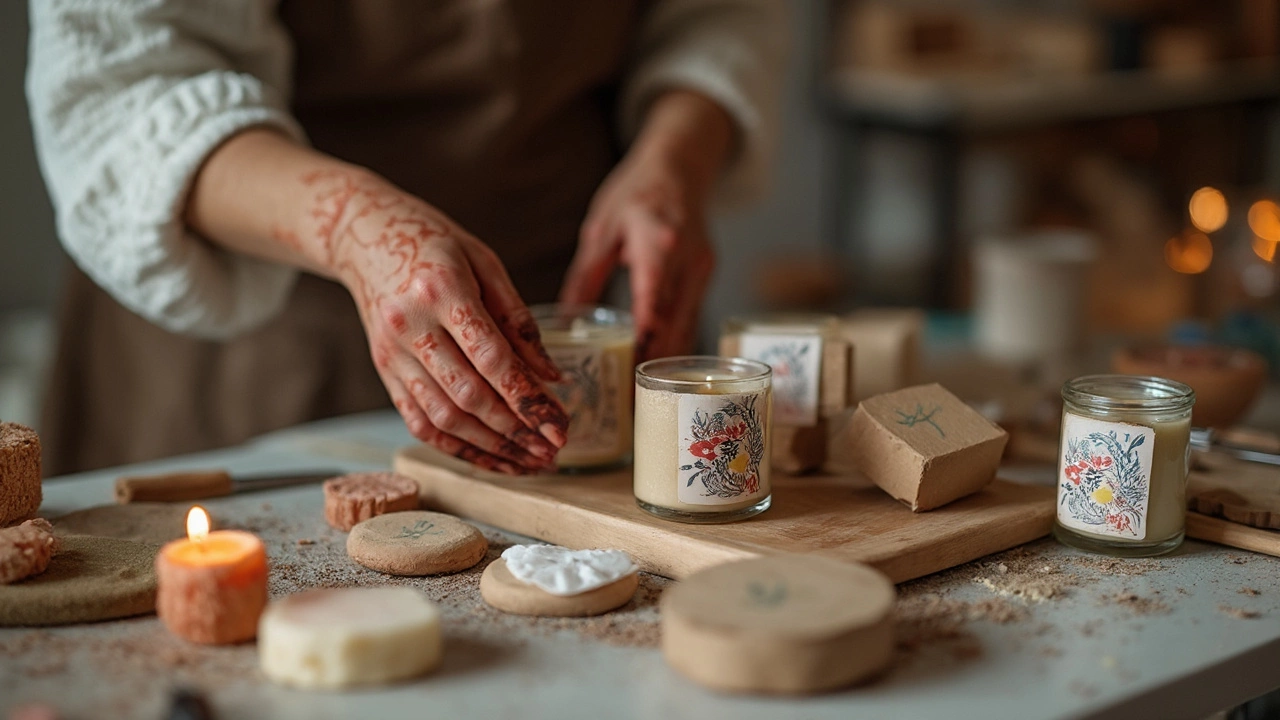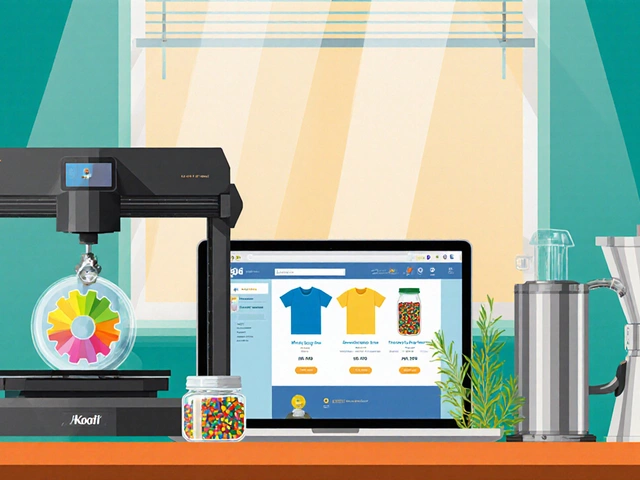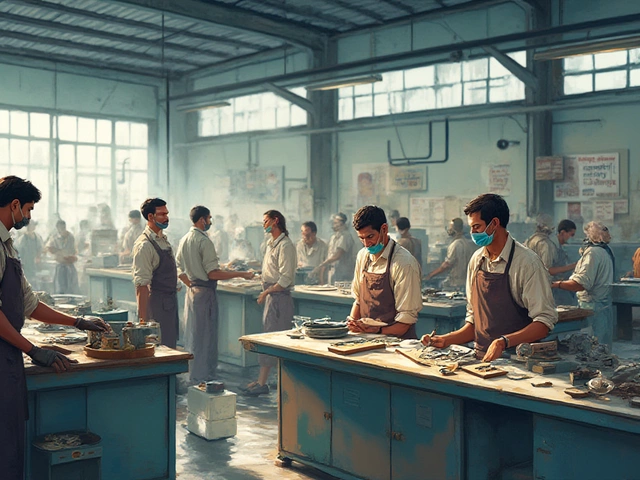Candle making is one of those small scale businesses that actually make sense for beginners—and honestly, for anyone who wants to have some fun while earning a side income. You don’t need a massive warehouse or expensive machines. People start these kinds of businesses in spare bedrooms, garages, or even at their kitchen table. All you really need are some basic tools, materials like wax and wicks, and workable ideas for scents or shapes.
Why pick candle making as an example? It’s simple. The ingredients are cheap, the process isn’t rocket science, and there’s always a market. People buy candles for celebrations, gifts, relaxation, or just to make their homes smell good. And with so many ways to brand and style your candles, you can stand out even in a crowded market. Plus, if you keep it small, it's all stuff you can actually handle yourself or with a small team of trusted folks.
- A Closer Look at Candle Making
- How Much Space and Equipment Do You Need?
- Start-Up Costs: Keeping It Manageable
- What Makes Candle Making Popular?
- Pitfalls and Real-World Tips
- How to Take It Further
A Closer Look at Candle Making
When it comes to small scale business ideas in manufacturing, candle making stands out for being simple, low-cost, and flexible. You don't need a science degree—just some basic know-how, the right supplies, and a bit of creativity. The process is straightforward and doesn’t require massive machinery or huge investments up front.
The main supplies you’ll need are wax (soy, paraffin, or beeswax are the top picks), wicks, a pouring jug, a melting pot, and containers or molds. You'll also want scents and color dyes if you plan to customize your candles. For small batches, most of this stuff is easy to find online or at a craft store.
Here’s the basic process to make candles:
- Melt the wax in a dedicated pot or double boiler.
- Add fragrance and color, stirring gently to blend.
- Place the wick in your container or mold.
- Pour in the melted wax and let it set.
- Trim the wick—and done!
One big plus of small candle making operations is how quickly you can pivot. You can switch up scents or shapes as trends change. There’s also room to go eco-friendly, using vegan ingredients or recycled containers, which is a huge selling point for many buyers now.
To give you a clearer picture, here’s a simple breakdown of what a small candle studio might look like compared to a bigger setup:
| Type | Space Needed | Batch Size | Start-Up Cost |
|---|---|---|---|
| Home-Based | 10–20 sq. ft. | 10–20 candles | $200–$500 |
| Small Workshop | 100 sq. ft. | 50–200 candles | $3,000–$7,000 |
If you’re into crafting or looking for a business you can start while keeping your day job, candle making checks a lot of boxes. And unlike food businesses, you don’t have to worry so much about red tape and heavy regulations. That’s a win for anyone itching to get started fast.
How Much Space and Equipment Do You Need?
Here's the good news: you don't need a factory floor or a ton of cash to start your small scale business with candle making. Lots of folks kick things off right at home. Think a tidy corner of your garage, a spare room, or even the kitchen if you’re careful about spills. For a basic setup, about 50 to 100 square feet will do the trick—that's less space than a single car garage.
When it comes to equipment, you can start with the basics and upgrade as your business grows. For beginners, you’ll want:
- Double boiler or even a big pot to melt wax
- Pouring pitcher (metal works best)
- Thermometer (candle wax isn’t forgiving if overheated)
- Basic molds and containers—think glass jars or tins
- Wicks, of course
- Stirring sticks or a spoon
- Digital scale for accuracy in measuring
- Mixing fragrance oils and color dyes
- Work surface covered with old newspaper or a silicone mat
If you want to make more candles at once, you’ll need more molds and maybe a bigger melting pot. Still, even a more ambitious home setup rarely needs more than a couple hundred square feet.
For folks who love numbers, check this simple layout of starter costs (all prices in USD):
| Item | Estimated Cost |
|---|---|
| Double Boiler | $25 |
| Pouring Pitcher | $15 |
| Basic Molds/Containers (set of 10) | $20 |
| Thermometer | $10 |
| Digital Scale | $20 |
| Starter Wax and Wicks | $30 |
| Fragrance Oils & Dyes | $30 |
| Total | $150 |
Most of these tools are reusable, so you don’t need to restock often. That’s what keeps the overhead low and makes candle making a pretty smart example of a small scale manufacturing hustle.
Start-Up Costs: Keeping It Manageable
This is the part where most people worry—how much does it really cost to get a small scale business like candle making off the ground? The good news: it’s honestly not that scary. You can start on a shoestring and scale up as orders pick up.
Here’s a simple list of the basics you’ll need to buy if you’re making candles at home:
- Melting pot or double boiler (sometimes just an old pot will do)
- Basic thermometer
- Wax (soy, paraffin, or beeswax—soy is pretty affordable)
- Candle wicks (pre-tabbed is easiest for beginners)
- Candle molds or jars
- Fragrance oils and dyes (optional, but they help you stand out)
- Labels and packaging
You can grab starter kits online for as little as $40–$80, but let’s break down the numbers if you buy items individually. Here’s a rough look at the real money side of things:
| Item | Typical Cost (USD) |
|---|---|
| Wax (5 lbs) | $15–$25 |
| Wicks (50 count) | $8–$12 |
| Fragrance Oil (16 oz) | $15–$25 |
| Melting Pot | $10–$20 |
| Jars or Molds (12 units) | $15–$24 |
| Labels & Packaging | $10 |
You can easily get started for under $100 if you keep it lean. You don’t need fancy branding or custom glass jars from day one. Plenty of small scale manufacturing operations skip the frills and still make solid profits.
If you want a seasoned opinion, here’s a quote from the National Candle Association:
“Many successful small businesses in the candle industry started by selling simple products at local markets and gradually reinvesting profits to grow.”
The trick is to keep your first batch small, test what sells, and only scale up when your candles actually move. That way, you aren’t stuck with a pile of unsold stock or debt. Start-up costs stay low and manageable. This is one of the things that make candle making such a tempting choice for small scale business newbies.

What Makes Candle Making Popular?
There’s something about candle making that just pulls people in. First off, it’s affordable to start and easy to scale. You don’t need a huge investment or fancy machinery. A lot of folks jump in with a starter kit and basic tools, then grow to a real workshop as sales pick up. If you mess up a batch, you’re only out a few bucks, which isn’t the case with other types of small scale manufacturing.
Another big reason for its popularity? Customization. You’re not stuck making the same boring product over and over. Want to make lemon-scented soy candles in quirky jars? Go for it. Prefer classic beeswax in vintage tins? That’s cool too. This flexibility lets business owners cater to trends or focus on niche groups, like eco-friendly shoppers or people who love nostalgic smells.
Candles also sell year-round, which isn’t true for a lot of crafts. People buy them as gifts for holidays, birthdays, or just to treat themselves. The U.S. candle market, for example, was valued at about $3.6 billion in 2023—so there’s clear demand, and it doesn’t look like it’ll disappear anytime soon.
| Reason | Why It Matters |
|---|---|
| Low Start-up Costs | Affordable for first-time business owners |
| Easy to Customize | Adaptable to different styles and trends |
| Consistent Demand | Sells well for holidays, gifts, and home use |
Finally, social media and local markets make it even easier to promote and sell what you make. You can show off your new line of candles with a simple Instagram post, or set up a booth at the monthly craft fair and start building a loyal local following. That’s the power of a small scale business with a product people really want.
Pitfalls and Real-World Tips
When it comes to small scale business like candle making, the tricky part isn’t just melting wax and getting the scents right. There’s a bunch of behind-the-scenes stuff that can trip you up if you aren’t ready. For starters, safety always gets overlooked. Hot wax and open flames are a risky combo—use a thermometer and never leave melting wax alone. Insurance might sound boring, but it’s a life saver in case something goes wrong. Believe it or not, a lot of new candle makers forget to check if their scents or colors are skin-safe or non-toxic. That’s a shortcut to lost customers (or worse, legal headaches).
Sales go up and down throughout the year. You’ll sell a bunch at Christmas, but not so much in July unless you have a niche, like outdoor citronella candles. It helps to plan your production schedule to match busy seasons and avoid sitting on a pile of unsold stock.
Be careful with pricing—too low and you barely break even, too high and buyers go elsewhere. Track your costs tightly from the start: wax, containers, scents, labels, packaging, and even your time. Here’s the thing: small mistakes add up fast. According to CandleScience, “The most common mistake in candle making is not tracking expenses and underestimating time spent on each batch.”
“Everything from custom labels to shipping costs can eat into profits if you aren’t watching them. You need to know your numbers before you ramp up.” — CandleScience
One more heads-up: customers expect consistency. If your first batch smells amazing but the second one is weak, people notice. Stick to tested recipes and track all your steps. Don’t skip test burns. Smells can shift after a few hours or days, and wicks can work differently depending on the jar or wax type. Write down what works so you aren’t guessing next time.
- Use small test batches before committing to a big run.
- Label every batch and take notes on performance.
- Set aside time for proper cleanup—it gets sticky, fast.
- Watch shipping in hot months; candles melt in transit.
- If you’re thinking about fancy shapes or colors, double check what works (and what cracks or bleeds color).
Here’s a snapshot of what can eat your budget if you aren’t careful:
| Expense | Likely Cost (per batch, 50 candles) |
|---|---|
| Wax | $30 |
| Wicks | $5 |
| Scents/Essential Oils | $15 |
| Containers | $40 |
| Packaging | $20 |
| Labels | $10 |
Sticking to these real-world tips keeps your small scale manufacturing dreams on track. Avoid the shortcuts—smart prep pays off later.
How to Take It Further
So you’ve got the basics of small scale business candle making down. Now what? The cool thing is, you aren’t stuck just cranking out the same vanilla-scented jars. There’s a real market for custom and unique candles, and this is where people start to scale up and make real money. Think about branching into themed designs, limited edition scents, or even collaborations with local artists. The variety is almost endless if you’re willing to get creative.
One smart move is to tap into local markets and events. Setting up a booth at craft fairs or farmers' markets gets your candle making products in front of people who actually want to buy handmade goods. Social media is a must too. Instagram and Facebook are the obvious picks, but don’t sleep on TikTok if you can show quick behind-the-scenes videos—short, real clips sell way better than slick ads.
Ever thought about subscriptions? Some small candle makers offer subscription boxes where customers get new candles every month. Not only does this build a loyal base, but monthly recurring revenue takes off the pressure to constantly find new buyers. According to a 2024 survey by Statista, over 15% of U.S. consumers signed up for at least one subscription box—candles are often in the top five products for home and lifestyle subs.
If you’re looking at scaling, here’s a short checklist:
- Invest in a larger wax melter if you’re making more than 100 candles per week.
- Register as a business and deal with local regulations early—fire department rules especially.
- Try bulk buying supplies to drop your per-candle costs. This can mean more profit per sale, even if you don’t raise your prices.
- Create a simple website. Folks want to find your small scale manufacturing setup online, not just on social.
- Explore eco-friendly options—soy, beeswax, reusable jars. People are willing to pay more for green products.
You might be surprised, but plenty of small candle brands hit six figures in revenue once they get regular wholesale orders from gift shops and boutiques. It takes time and hustle, but starting small gives you a safe way to learn and grow. Track your progress, get honest feedback, and tweak your products until you find your sweet spot in the crowded world of small scale business.






